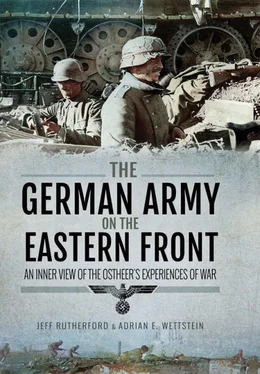The troops, who can scarcely get any rest, are completely exhausted physically, have reached the edge of their effectiveness and are no longer capable of offensive actions.
On the defensive, the front only holds when the artillery is the decided bearer of the defence and the man in the trench knows that tanks or a mobile panzer defence is behind him. The troops can only move forward for counterthrusts through extraordinarily spirited leaders under the accompaniment of tanks or assault guns. The high losses of precisely the best leaders and soldiers have left hardly any such leaders. In case of enemy breakthroughs, continual crisis situations are the result. The ceaseless large-scale combat, without any possibility for sufficient sleep or the necessary quiet and care, has taken its toll on the troops so that even the strongest wills can no longer muster the strength to resist or for the simplest tasks of daily life. A long period of rest is urgently required for refreshment and training in order to cover the missing leaders, NCOs and specialists and to train the replacements (partially older year age group, men rated as indispensible, men from Alsace) who are in no way sufficient for the demands of the war in the east.
The loss of artillery observers, signal personnel of all units and drivers and medical personnel is threatening. Therefore, crisis situations that arose could only be mastered through the mobilization of all strength. It must again be started here through systematic training.
In line with the high casualties are the division’s losses of weapons. Without assault guns, panzer security is no longer available due to the very high losses of weapons in the anti-tank battalion and the 14th Companies. The equipping of the division with self-propelled ATGs has proven itself to be absolutely necessary […]
Mobility:
Due to the high losses in horses and vehicles, mobility has considerably sunk from that of the previous month.
Infantry is on average 75% mobile.
Artillery with the light battalions is about 60%, with the heavy battalion, 55%.
During a march movement, numerous vehicles can only move in shuttle traffic.
Mobility of the heavy ATGs have sunk to 50% due to the losses of towing vehicles.
2) Morale and Mood
With its deprivations and stresses, the large-scale battle depressed the attitudes of the overburdened troops, without leading one to characterize their attitude as bad.
Political events, the continual attacks on the cities of the Heimat shake the heart and mind of the soldiers. All of these events together cripple the confident mood.
When the soldiers can again properly rest and sleep, the attitude will quickly reach its old high level. […]
Concluding Judgement:
Due to its present combat strength, the condition of each individual soldier, [and] the weapon and equipment outfitting, the division is not capable of an attack. With support from assault guns or tanks, after the feeding of the necessary number of officers, and when it is freshly rested, it can defend a sector appropriate to its strength.
The various issues that afflicted German combat efficiency during the war in the east all emerge in this document. Heavy casualties were simply not made up for by newly arriving replacements and, perhaps even more importantly, those killed and wounded were the experienced officers, NCOs and veterans of the rank and file desperately required by the unit during a period of such high-intensity combat. Losses of specialists were similarly detrimental to the divisions as the incoming soldiers from the rear did not possess the necessary training to fill these vital roles. Material deficiencies – ranging from shortages of horses and vehicles to ATGs and assault guns – significantly limited both the division’s mobility and its defensive capabilities against Soviet armour. Finally, the battle itself cannot be separated from the larger context of the war: while the men struggled against a more powerful and mobile foe, they were also aware of the bombing of their homes and the developing situation in Italy. Morale in 1943 increasingly became an issue that worried German authorities. In sum, these various issues led to the formation – a first-wave, elite infantry division – being classified as not only incapable of attack, but also able to mount a strong defence only after certain conditions had been met. This exemplified the ‘infantry crisis’ that plagued the German army from mid-1943 on, one further discussed in chapters 3and 6.
Following the defeat at Kursk, the pendulum of war permanently swung in favour of the Red Army, as it maintained the initiative for the remainder of the conflict. While the Soviet offensive to the north of the Kursk salient sparked the end of Operation Citadel, it was the counter-offensives to the south in the second half of 1943 that put real pressure on the German army in the east. The following report issued by the 306th Infantry Division highlighted the experiences of a German unit during this period of combat and retreat. [47]
1) The attached report of an experienced regimental commander proven in heavy fighting accurately portrays the condition of the troops known to me for weeks.
Under strictest application of Führer order No.6 with pistol in the hand, Oberstleutnant Wittmüss had [again] personally led companies to the front, whose officers had fallen. He has again proven the necessary hardness for large-scale, intensive fighting.
He has been instructed by me, that an extraction of the 306th Infantry Division or even parts of it seems impossible in the actual operational and tactical situation.
2) After consultation with the divisional doctor, I report on the health condition of the fighting troops:
a) All cases of non-communicable diseases remain with the troops.
b) Since the troops had no opportunity for bathing or washing for 2½ months, they are completely full of lice.
c) 60% suffered from scabies, 20% have lower-leg ulcers or extensive periarthritis.
d) Under normal circumstances, around 25% of the fighting troops had to be treated for 3-4 weeks in a military hospital.
e) The combat power suffers from complete physical exhaustion. It was found several times that individual soldiers were no longer responsive or that their will to survive had fully disappeared.
Appendix: Grenadier-Regiment [48]579/Cdr., Value judgement on the combat power of the regiment, 1.12.43
In its current condition, the regiment as a unit cannot cope with offensive or defensive tasks.
Through uninterrupted action lasting for weeks, combat morale and the state of training have decreased to a point, which can only be termed as deficient.
Its causes lay in the following:
1) A welding together of the Kampfgemeinschaft has been largely hampered by disproportionately numerous changes in command and fluctuations of rank and file through casualties. For example the I. battalion has changed its battalion leader ten times since the last Mius battle. In the period from the beginning of October until now, 28 company and battalion leaders have been withdrawn due to injuries, with an average of 6 companies in action. In the same period, while 48 NCOs were sent as replacements, 76 NCOs were wounded, and with 525 men sent as replacements, 586 fell out. The balance between replacements and losses has been covered by the combing-out of the baggage train. Losses were nearly completely men from the [regiment’s] combat strength.
2) The physical demands of officers, NCOs and rank and file have reached a dimension in the last weeks that exceed the soldiers’ strength. The rank and file’s state of exhaustion, which leads to indifference towards all events and disinterest in one’s own fate, has up to now been balanced out only to a certain percentage by the unparalleled example and ruthless severity of officers and the few remaining NCOs, who in many cases forced the will to resist in the frontline with pistols in hand.
Читать дальше






![John Stieber - Against the Odds - Survival on the Russian Front 1944-1945 [2nd Edition]](/books/405234/john-stieber-against-the-odds-survival-on-the-russian-front-1944-1945-2nd-edition-thumb.webp)





